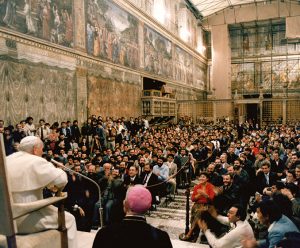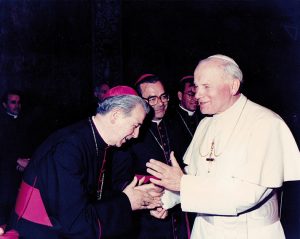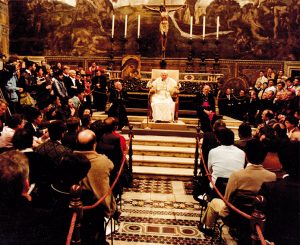Audience in the Sistine Chapel to young future priests March 31, 1985
St. John Paul II
Vatican – Sistine Chapel, March 31, 1985
Yesterday afternoon, one thousand, two hundred and seven young men committed in the Way which will lead them to the priesthood, have livened up a long meeting with the Pope in the Sistine Chapel, crowded as never before. Kiko Argüello, initiator of the Neocatechumenal Way, presenting the assembly to the Holy Father, affirmed that these young men had come to Rome for the great international gathering of youth and to participate in a special meeting reserved for young Neocatechumens who, through the Way, have discovered the vocation to the priesthood. Although they came from about sixty countries, most of the young men were Latin Americans, happy to be able to demonstrate to John Paul II how they had received the invitation that he addressed to them in Peru, during his recent visit to the “Continent of Hope”, to “Go and return to your nations to evangelize.”

The meeting in Rome of young neocatechumens has been described by the young men themselves as “an immersion in Baptism” and developed, delving into three fundamental aspects in the way of the future priests: the Liturgy, the sacramental aspect; that of the Word, spouse of the priest, with a special reflection on St. Luke chapter 9; and the Church. Special importance has been given to the rediscovery of the local Church. It was the Kiko again who illustrated to the Holy Father the characteristics of the group and the place of origin of the participants. There, it has revealed a complete picture of the commitment taken by the Neocatechumenal Communities worldwide for the birth and deepening of vocations of special consecration. Today there are many young men who enter the seminary thanks to the Neocatechumenal Way, they have demonstrated it speaking of their own experience. Two among many spoke: one from Santo Domingo and the other from Munich, Bavaria. The Brazilian Bishop of Jundiaí, Roberto Pinarello de Almeida, has affirmed that the seminary of his diocese has taken on the methodology of the Neocatechumenal Way for the formation of seminarians: the ‘Tripod’ of the Word, the Liturgy and the Community is a extremely effective nourishment for the seminarian who thus places himself at the service of the Church and for the Church.
“I would like to summarize the reflections that I have been having during this meeting: spontaneous reflections, immediate and, at the same time, of the moment. We have done a little geography and statistics. We have traveled the world: from Mexico, all of Central America, Antilles, all of Latin America, and then we have passed to the Pacific, Australia, Japan, China, Taiwan; and I don’t know how we haven’t gone to that great country between China and Poland. We have also gone to several European countries and I have noticed that Italy is also quite well represented, not just Spain; a little less Poland but there are also seminarians from this country, thanks be to God.
While configuring the geography and statistics, I thought that we should always refer, even with statistical matters, to spiritual things, to the Holy Spirit, because there is one statistic that is only known through its person and its mysterious working in the soul. We are all instruments, sacramental and sacred instruments of its workings; but what is important is its actions, the instrument is always secondary, although necessary; and necessary because the Church is not the heavenly Church, but the terrestrial Church, that of men, and men are called to form the Church. There must be a call; Christ acted like this: He called. He began to preach and evangelize, but he immediately called from the first days. This process of vocation, of calling, must be repeated; Furthermore, this process of vocation constitutes a certain proof of the authenticity and maturity of the Church, both of the universal Church and of the specific, local Church. I remember the days of my youth and the years when I was a bishop in Krakow, when each parish was evaluated according to the priestly and religious vocations it had; this was a sign of the vitality and maturity of the Church.

I am getting to know your Neocatechumenal Way more and more, in different circumstances and always briefly; but from these fragments a whole is made up. I would like to tell you what seems essential to me. You place the sacrament of Baptism at the center of your spirituality. What does Baptism mean? Many things, but amongst everything that makes up the great theology of sacred Baptism, there is one: the first consecration of the human person to God in Jesus Christ. Certainly, there are many, many baptized people who have little or no awareness that it is the first consecration. On the other hand, if one makes a complete, existential, truly religious evaluation of his Baptism, at least once will he encounter this reality: I am a person consecrated to God. In this first and fundamental consecration, it is easier to detect the priestly or religious vocation. This does not mean a lesser appreciation of the Christian in general, of the Christian vocation as such, of the vocation of all the laity; you even have a layman as your guide; Saint Francis of Assisi did not want to become a priest and accepted only the deaconate ordination. Certainly, every Christian vocation is marked, characterized by this consecration of the person, of the man and of the woman, to God. If this is understood, it is easy to understand also the vocation of man who, starting from his initiative which guided by divine grace, offers himself to the service of God, Christ and the Church, dedicates himself to complete and total service in priestly consecration and in religious consecration, consecrations somewhat different from each other but very convergent. And this is a fruit of meditation on and a deepening of the mystery of Baptism, so it is not surprising that vocations arise in your Way; this confirms that your way is authentic and responds to its nature and denomination. So, here you have the main thing I wanted to tell you. Now another point quite related to this situation. We are in the Sistine Chapel, famous above all for its wonderful paintings, especially Michelangelo’s ‘The Last Judgment’. And also known for an event. We are all pilgrims due to the fact that the conclaves take place here and the Popes, bishops of Rome, are elected. Last time more gathered than in previous Conclaves and elected an unknown Pope, but who has discovered an itinerant vocation.

And so we are itinerant. This is another facet of your way. The Apostolic Church was itinerant, of course, and the most itinerant of the apostles was Saint Paul, without a doubt. Today the Church is also itinerant, all are itinerants, even those who do not change places or move house in their life, because we are all pilgrims, and pilgrim means something more than itinerant; we are all pilgrims in the Holy Spirit, pilgrims going towards the Father’s house, and Christ guides us through the Holy Spirit. I want to add something else. Here, in this Chapel and around this Chapel, many prayers are made around the world when the time comes for the death of a Pope and the election of his Successor.
I want to end this meeting by praying with you to the Holy Spirit for vocations; so necessary in the Church. We also make a statistic regarding the Universal Church and we must do it. Just yesterday, with Mons. Sustituto, we talked to representatives of the Statistical Office of the Church; the Church of today must make great efforts in prayer and in the contacts with the Holy Spirit to stay alive, to keep up the number of vocations, because this number is threatened in some Churches, and in others it is insufficient, already for a long time.
Let’s end by praying a mystery of the Rosary, the mystery of the Holy Spirit, the third glorious mystery, because here in this Chapel you must always pray the mystery that refers to the Holy Spirit; and for vocations.”